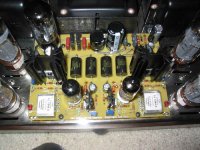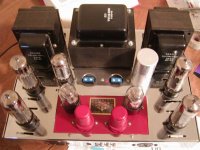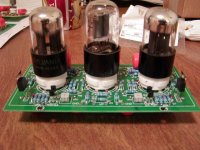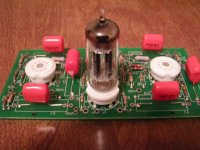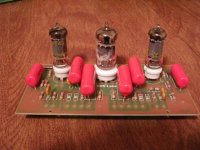Salvaged ST70 Breadboard for testing
I managed to find a trashed and practically destroyed Stereo 70 at a garage sale this weekend. It looked like it had been in a fire. I asked the owner about it and it was in fact burned in a fire when a detached storage unit went up in flames a few years ago.
Thinking that perhaps the iron was salvageable, I offered him five bucks for the burned out ST70. He accepted and went home with the burned out Dynaco carcass.
The transformer covers and the chassis were all rusty, but looking at the inside of the amp I was surprised that it wasn't all that charred. At least the cloth on the transformer wires was intact. I unbolted all the transformers from the chassis and removed the rusted transformer covers. Internally, all of them looked fine. The paper was a little blackened but everything looked intact. I checked each one, comparing them to some good ST70 transformers and saw comparable values. I then wired them into another ST70 and was surprised that they sounded fine.
I just happened to have some spare ST70 parts around including a new driver board. Since I didn't have a chassis I decided to use an old shelf to mount the parts. My goal was to have an "exploded" ST70 to experiment with different boards and power supply configurations. I'm still in the midst of assembly, but will keep the forum posted with the outcome and how it sounds. Obviously I wouldn't recommend this configuration to anyone that doesn't have experience with tube amps or has small children around as the exposed high voltage would make it less than safe.
I managed to find a trashed and practically destroyed Stereo 70 at a garage sale this weekend. It looked like it had been in a fire. I asked the owner about it and it was in fact burned in a fire when a detached storage unit went up in flames a few years ago.
Thinking that perhaps the iron was salvageable, I offered him five bucks for the burned out ST70. He accepted and went home with the burned out Dynaco carcass.
The transformer covers and the chassis were all rusty, but looking at the inside of the amp I was surprised that it wasn't all that charred. At least the cloth on the transformer wires was intact. I unbolted all the transformers from the chassis and removed the rusted transformer covers. Internally, all of them looked fine. The paper was a little blackened but everything looked intact. I checked each one, comparing them to some good ST70 transformers and saw comparable values. I then wired them into another ST70 and was surprised that they sounded fine.
I just happened to have some spare ST70 parts around including a new driver board. Since I didn't have a chassis I decided to use an old shelf to mount the parts. My goal was to have an "exploded" ST70 to experiment with different boards and power supply configurations. I'm still in the midst of assembly, but will keep the forum posted with the outcome and how it sounds. Obviously I wouldn't recommend this configuration to anyone that doesn't have experience with tube amps or has small children around as the exposed high voltage would make it less than safe.
'Sploded ST70 Photo
Here's a pic of the ST70 that I mounted on a board for test purposes:
http://www.flickr.com/photos/dnagent/3302260414/
Here's a pic of the ST70 that I mounted on a board for test purposes:
http://www.flickr.com/photos/dnagent/3302260414/
Here's a pic of the ST70 that I mounted on a board for test purposes:
Why not purchase a used chassis for $60 or less and put it back together?
Its no easier to change the driver board the way you have it set up than it would be to change the board when its in a chassis.I've done it a number of times. I can change one in less than 5min.
Having it in the chassis would give an accurate idea of how it would sound because you could be having noise problems having it strung across a piece of plywood board.
Dynaco ST70 Upgrades
I just came across this thread recently and noticed there have been several posts asking for info. about the K and K Audio ST70 Upgrade Kit. I was the first to obtain and install these upgrades in the beta version and have had the opportunity to listen over a long period of time to many types of music with different preamps, speakers and source components in my system. At first, the resulting sound for me was a quantum leap beyond what I heard from the stock unit. After an extended period of break-in time, especially for the coupling caps, the sound continued to improve significantly more. In my opinion, this design is capable of performance with sonics that rival and exceed some of the best Class A amps on the market that I’ve heard.
The Dynaco ST70 was originally released in 1959 and considered by many to sound quite good. It was especially popular among DIYers. Several years ago I purchased a vintage ST70 and was disappointed in its performance. By today’s standards, the stock ST70 (both factory built and kit built) cannot compete with many contemporary entry-level tube amplifiers. That is the reason there are so many upgrade kits available. I haven’t heard them all, but undoubtedly, most improve its performance enough to make it a worthwhile DIY project.
The K and K audio ST 70 upgrade design makes excellent use of solid-state devices and vacuum tubes combined to work in a circuit topology that is radically different and bears no resemblance to the original ST-70. It is a very attractive path to assembling a high-performance amplifier using only some parts of an existing ST-70.
Kevin Carter's impressive sounding, pure Class A design uses a Lundahl amorphous core input transformer for phase splitting in place of the 7199 tube. Besides achieving very accurate phase splitting across the bandwidth, Kevin points out that the input (or interstage) transformer “provides galvanic isolation between the source and the amplifier, removing the possibility of ground loop hum involving the power amplifier…” Following the input transformer, a pair of 6N23P (6922) tubes is used in a differential stage to drive the EL34 output tubes through four coupling capacitors. According to Kevin “this input stage provides relatively high gain and very symmetrical drive to the output stage at a moderately low impedance.”
In the differential PP output stage, a pair of paralleled current sources is used, with a CCS in the tail, to which both cathodes of the EL34s have been connected. EL34 bias is adjusted by setting the current sources for the bias current of your choice. Besides operating the input stage as a Class A differential amplifier, the output stage also is true Class A differential and can be configured to operate in ultralinear (35w per channel) or pure triode mode. No global feedback is used. Kevin also explains: “Operating the output stage differentially also means that the output tubes "track" each other dynamically (as well as their initial matching allows.) This lowers distortion and dramatically improves sound quality..."
The power supply is robust and made simple by virtue of the good power supply rejection provided by differential amplifiers.
The modified ST70 sounds very dynamic and its 10W per channel (triode connected) must be heard to be appreciated. The sound is very open, airy, transparent and musical. To my ears, it rivals some very good single-ended amps I've heard. There is more than enough power to drive my pair of 90dB Green Mountain Audio EOS HD monitors effortlessly.
I’ve rolled various tubes including EL34s, KT77s and the new Tung Sol 6550s. The amp has performed well with all of these and the sound is somewhat different with each. Swapping tubes is easy since the bias is self-adjusting. Recently, Kevin Carter recommended a different MOSFET that he had tried and said made a further improvement in the sound. After installing these, I could discern even more openness with added air around instruments and voices, along with an increase in clarity and in soundstage dimensionality.
The kit can be purchased in various configurations depending on budget and performance needs. Although the original A470 OT is very good (to some, even ‘legendary’) the kit can also be used with modern transformers in the chassis of your choice. Link: http://www.kandkaudio.com/poweramplifier.html
Disclaimer: I have no commercial ties with KandKAudio. This post is intended only to provide a response to this thread by sharing personal experience gained from a completing a DIY project.
I just came across this thread recently and noticed there have been several posts asking for info. about the K and K Audio ST70 Upgrade Kit. I was the first to obtain and install these upgrades in the beta version and have had the opportunity to listen over a long period of time to many types of music with different preamps, speakers and source components in my system. At first, the resulting sound for me was a quantum leap beyond what I heard from the stock unit. After an extended period of break-in time, especially for the coupling caps, the sound continued to improve significantly more. In my opinion, this design is capable of performance with sonics that rival and exceed some of the best Class A amps on the market that I’ve heard.
The Dynaco ST70 was originally released in 1959 and considered by many to sound quite good. It was especially popular among DIYers. Several years ago I purchased a vintage ST70 and was disappointed in its performance. By today’s standards, the stock ST70 (both factory built and kit built) cannot compete with many contemporary entry-level tube amplifiers. That is the reason there are so many upgrade kits available. I haven’t heard them all, but undoubtedly, most improve its performance enough to make it a worthwhile DIY project.
The K and K audio ST 70 upgrade design makes excellent use of solid-state devices and vacuum tubes combined to work in a circuit topology that is radically different and bears no resemblance to the original ST-70. It is a very attractive path to assembling a high-performance amplifier using only some parts of an existing ST-70.
Kevin Carter's impressive sounding, pure Class A design uses a Lundahl amorphous core input transformer for phase splitting in place of the 7199 tube. Besides achieving very accurate phase splitting across the bandwidth, Kevin points out that the input (or interstage) transformer “provides galvanic isolation between the source and the amplifier, removing the possibility of ground loop hum involving the power amplifier…” Following the input transformer, a pair of 6N23P (6922) tubes is used in a differential stage to drive the EL34 output tubes through four coupling capacitors. According to Kevin “this input stage provides relatively high gain and very symmetrical drive to the output stage at a moderately low impedance.”
In the differential PP output stage, a pair of paralleled current sources is used, with a CCS in the tail, to which both cathodes of the EL34s have been connected. EL34 bias is adjusted by setting the current sources for the bias current of your choice. Besides operating the input stage as a Class A differential amplifier, the output stage also is true Class A differential and can be configured to operate in ultralinear (35w per channel) or pure triode mode. No global feedback is used. Kevin also explains: “Operating the output stage differentially also means that the output tubes "track" each other dynamically (as well as their initial matching allows.) This lowers distortion and dramatically improves sound quality..."
The power supply is robust and made simple by virtue of the good power supply rejection provided by differential amplifiers.
The modified ST70 sounds very dynamic and its 10W per channel (triode connected) must be heard to be appreciated. The sound is very open, airy, transparent and musical. To my ears, it rivals some very good single-ended amps I've heard. There is more than enough power to drive my pair of 90dB Green Mountain Audio EOS HD monitors effortlessly.
I’ve rolled various tubes including EL34s, KT77s and the new Tung Sol 6550s. The amp has performed well with all of these and the sound is somewhat different with each. Swapping tubes is easy since the bias is self-adjusting. Recently, Kevin Carter recommended a different MOSFET that he had tried and said made a further improvement in the sound. After installing these, I could discern even more openness with added air around instruments and voices, along with an increase in clarity and in soundstage dimensionality.
The kit can be purchased in various configurations depending on budget and performance needs. Although the original A470 OT is very good (to some, even ‘legendary’) the kit can also be used with modern transformers in the chassis of your choice. Link: http://www.kandkaudio.com/poweramplifier.html
Disclaimer: I have no commercial ties with KandKAudio. This post is intended only to provide a response to this thread by sharing personal experience gained from a completing a DIY project.
Attachments
Re: Dynaco ST70 Upgrades
But still, it smells just like
drcg said:Disclaimer: I have no commercial ties with KandKAudio. This post is intended only to provide a response to this thread by sharing personal experience gained from a completing a DIY project.
But still, it smells just like
An externally hosted image should be here but it was not working when we last tested it.
Here are some measurements for a completely stock Dynaco ST-70 -- the output tubes are Raytheon, one 7199 is an original Dynaco, the other is a GE -- the amplifier has not been modded in any way:
An externally hosted image should be here but it was not working when we last tested it.
An externally hosted image should be here but it was not working when we last tested it.
Jackinnj, What load and power level is the THD measurement taken at? What's the measurement bandwidth?
i keep a notebook at the workbench, but didn't log that one -- if my memory serves me correctly it was 1 watt into 8 ohms. I believe I set the upper bw limit at 80kHz, but it may have been 500kHz which is full open on the AP.
The amp has subsequently gone to Dynaco Heaven, i.e. ebay.
- Status
- This old topic is closed. If you want to reopen this topic, contact a moderator using the "Report Post" button.
- Home
- Amplifiers
- Tubes / Valves
- Dynaco Stereo 70 amplifier
